Float Fishing For Salmon: My Guide Tips To Do IT Better
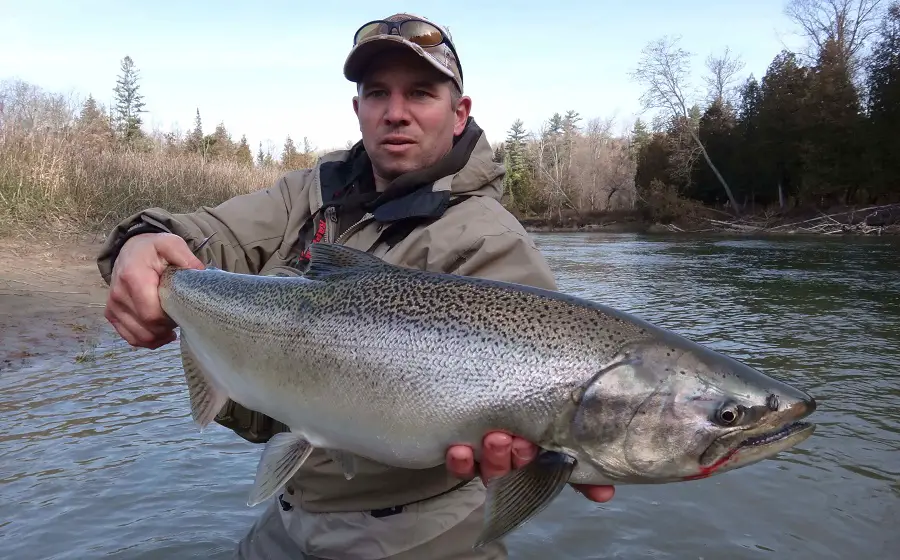
Float fishing is one of the most effective ways of catching salmon in rivers and is a method I have been using for over 37 years.
These are the things that I teach my clients who want to learn how to float fish for salmon:
- Rods: Use long rods of 11 to 14 feet with a line weight between 8 and 20 pounds
- Reels: Use spinning reels with a good drag and suitable line capacity, a Centerpin reel, or a baitcasting reel.
- Lines: Use a lightweight buoyant line such as Monofilament or braided lines.
- Leader Setup: Use my proven float fishing leader setup, which includes the leader, shot line, split shots, and hook.
- Presentation: Learn how to control your bait speed, control leader angles, and know how deep to set your float is critical
- Locating Salmon: Know when and where salmon will be running, where in the river is their travel route, and where they hold.
- Covering The Water: Knowing how to cover the water effectively will help you catch a lot more salmon.
- Baits: There are a few really effective baits for salmon that should be used 95% of the time.
I will discuss all of this and more below.
We may make a small commission from some of the links on this website, which is at no cost to you. I appreciate your support. Learn More
Float Fishing For Salmon
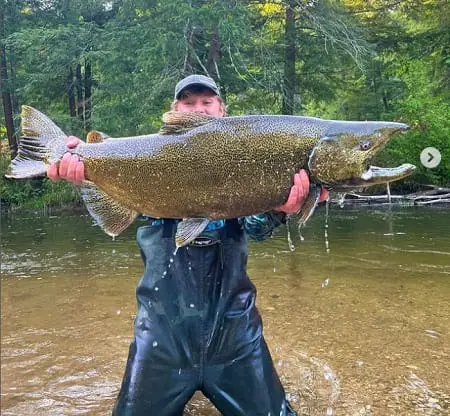
Many anglers think float fishing is simply a matter of putting bait on a hook, casting it out, and then watching your float drift down the river. They are very wrong.
Good anglers and good guides skillfully work their float throughout the drift, which results in ten-times more salmon.
The Fundamentals Of Float Fishing For Salmon
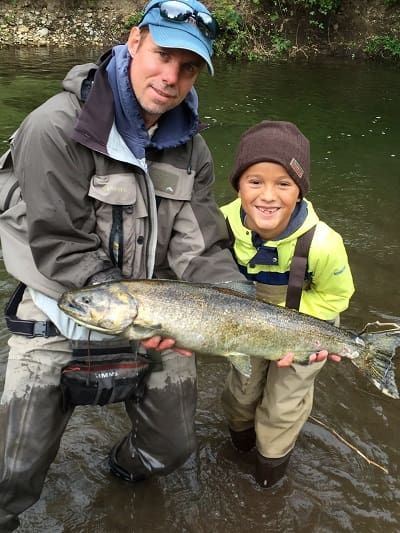
The five fundamentals of float fishing for salmon and steelhead are:
- Speed control
- Depth control
- Covering the water effectively
- Setup
- Rotating Baits
My most important guide tip is to make sure you do everything right.
One wrong thing means fewer fish!
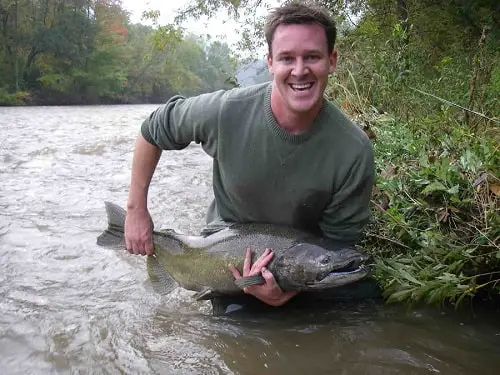
You could have the right rod, reel, bait, and float, but if your float is dragging too fast, or your float is not set deep enough, or it’s set too deep, or your leader is too thick, you won’t get any bites.
It’s critical to do it right.
Best Gear For Salmon Fishing – Fundamental #1
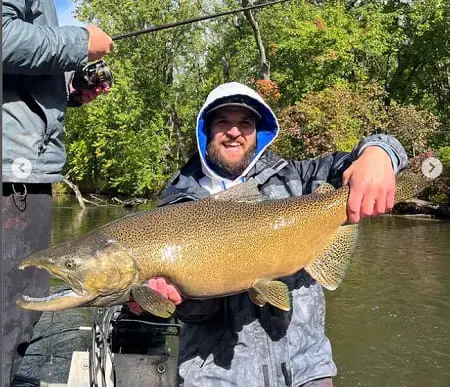
Going out and trying to float fish for salmon with your 7-foot lake casting rod will limit your ability to catch salmon, so don’t do it, and don’t use floats and lines that don’t work well in rivers.
You need the right rod, reel, line, and leader for this hard-fighting massive fish.
Float Fishing Rods For Salmon
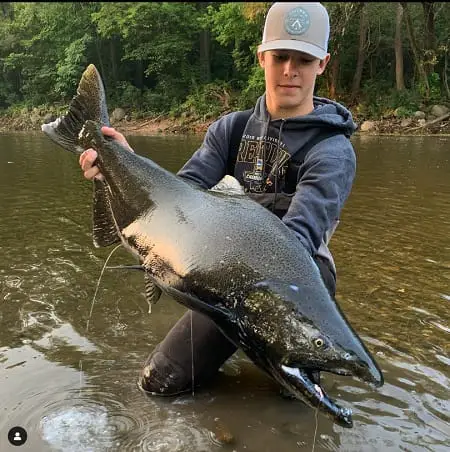
To float fish for salmon effectively, longer rods of 11 to 14-foot are best.
Longer rods will help keep your line off the water, and they will help you control the angle and the speed of your float and leader.
The longer rod will also act as a big shock absorber that will protect your leader so that you can use lighter leaders.
A rod like the 13-foot medium-light Lamiglas “The Closer” Centerpin Rod is a good option.
The next best rod, which is heavier for bigger rivers, is the Lamiglas Redline HS CenterSpin Float Rod, which can be used with a spinning reel or a Centerpin reel. For Salmon fishing, you want to get the 12-foot Medium, model number HS12CS – This rod sells for about $199.00
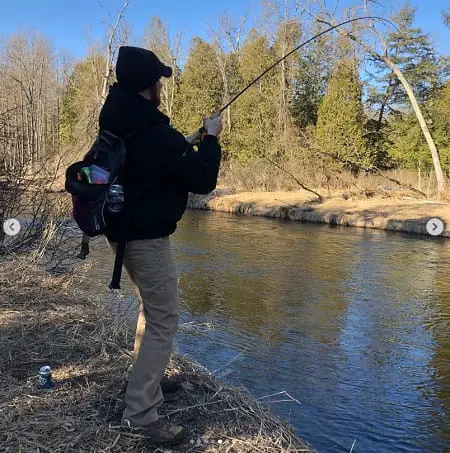
- Fenwick HMX Salmon & Steelhead Spinning Rod
- Lamiglas X-11 Salmon and Steelhead Spinning Rod
- Okuma Celilo Salmon & Steelhead Spinning Rod
Other great float rods for salmon fishing are:
For more on rods, check out my page, Best Salmon Rods For River Fishing.
Best Reels For Salmon Fishing
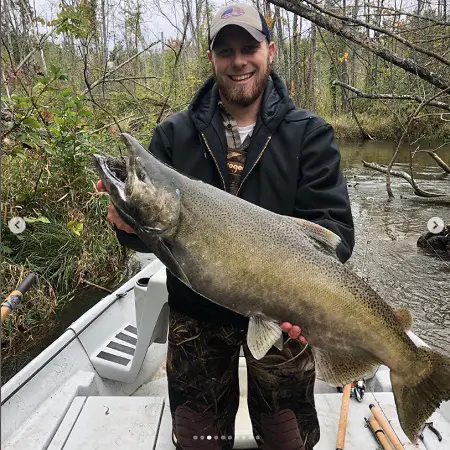
If you are using a spinning reel for salmon fishing, it’s best to use one that has a good smooth, drag with solid gears, and one that can hold plenty of line. One of the best spinning reels for salmon is the 3500 to 4500 Shimano Stradic FL.
I also use baitcasting reels for salmon fishing.
Best Centerpin Reels For Salmon Fishing
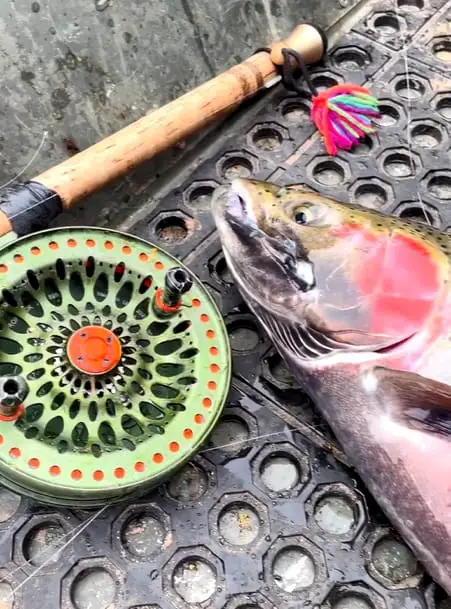
When It comes to Centerpin fishing for salmon, just about any of the Centrpin reels on my Best Centerpin Reels Page will do a great job. I discuss the pros and cons of these reels on that page.
Just avoid the super cheap Centerpins since they probably won’t last long on big salmon.
- Best Economy Centerpin Reel – Okuma Aventa
- Best Mid-Range Centerpin Reel – Raven SST Fully Ported – This is the reel I guide with the most.
- Best High-end Centerpin Reel – Kingpin Zepellin
Best Float Fishing Lines For Salmon Fishing
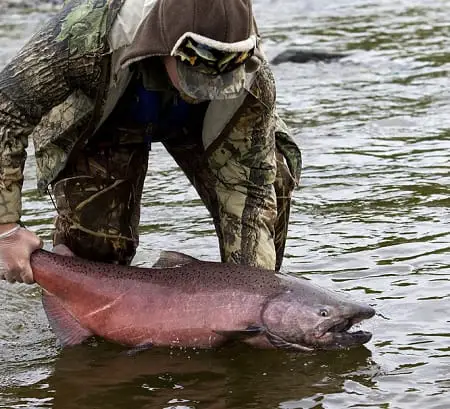
You will need a heavier line for salmon float fishing, and you want one that comes off the reel easily, one that is buoyant, and one that has been proven by other anglers.
For salmon fishing with Centerpin reels, I always use 10 or 12 -pound Raven high viz yellow mainline for Great Lakes Salmon in smaller rivers.
For bigger rivers and huge West Coast Salmon, consider 12 or 16-pound lines.
The other reason I like the Raven mainline is that it is lightweight, it sags less, and it’s buoyant, which is very important when float fishing.
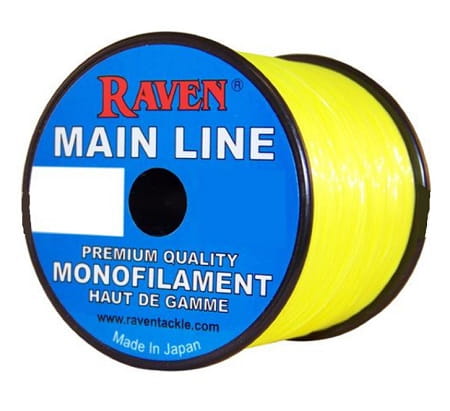
For spinning reels, I also like the 10-pound Sufix Elite Premium Mono in hi-viz-yellow.
When using colored lines or clear lines, it’s best to use a proper leader setup that the salmon won’t see and one that provides a great presentation.
The Best Floats For Float Fishing
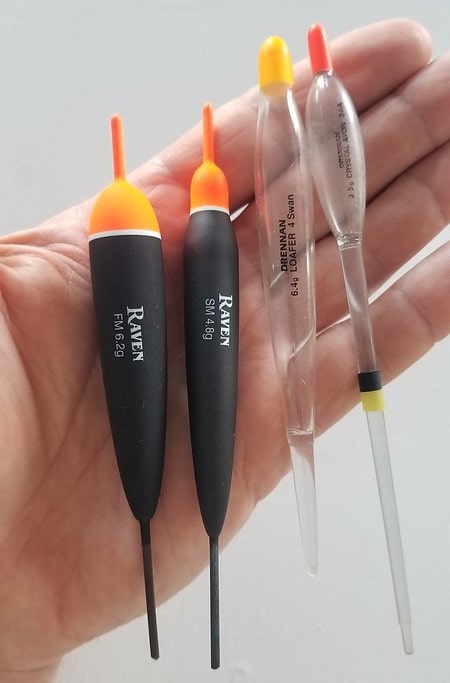
Having the right float is very important. The right float will help improve your presentation.
A good float will not just help you detect a biting fish, experts and serious anglers use their floats to help them get a natural speed and will help them find the bottom better.
My Favorite floats are the 6 to 10-gram Raven FM Balsa Floats for most rivers under 12 feet deep.
For bigger rivers that require longer-distance drifts or more weight, you might want to upsize to the 10-gram or 14 gram float.
I discuss the best floats at, 5 Best Floats For Float Fishing.
Salmon Leader Setup
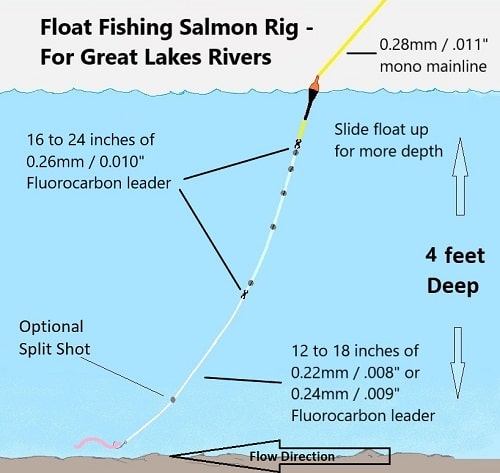
The leader setup is something that many new anglers get wrong.
Your leader must be strong enough not to break when fighting a large salmon, but thin enough that the salmon don’t see the leader and then refuse to eat the bait.
The leader that I use is made up of two parts and includes:
- Two different leader strengths – For the bottom leader, I use 0.22 to 0.24mm, and for the shot line, I use 0.26mm
- Swivels – Spro or Raven Micro swivels are good options
- Split shots – Good round black ones like the Sure Shot brand hold the line well and don’t damage the leader. I use the AA and AB sizes the most.
- Hooks – Gamakatsu Octopus Straight Eye Hook size eight or the Raven Specimen Hook in sizes 4 to10. I switch hook sizes to match my bait size.
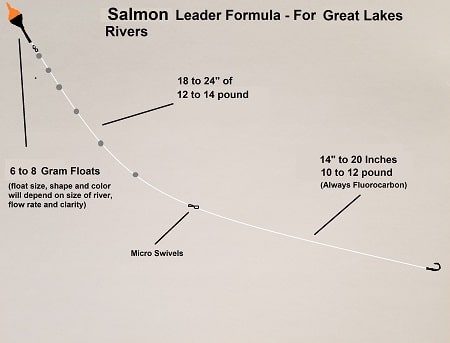
I use what is called a shot line, which is made with a fluorocarbon leader. It goes between the mainline from my reel and the leader that my hook is tied to.
This shot line is where all my weights (also known as split shots) go, and it allows me to put the weight on fluorocarbon and not on the mono mainline.
Pinching the split shots onto the fluorocarbon line is less likely to damage and weaken the line because fluorocarbon is more abrasion-resistant than the monoline on your reel.
Also, putting your weight here allows a longer total fluorocarbon length, which is more stealthy.
The fluorocarbon leader that I use for the shot line is either:
- 7-Pound Drennan Leader ( 0.26mm) – CHECK PRICE
- 10-pound Seaguar AbrazX Fluorocarbon Fishing Line ( 0.26mm)- CHECK PRICE
- 10-pound Seaguar STS Trout/Steelhead Fluorocarbon Leader ( 0.26mm)- CHECK PRICE
I also use a different sized fluorocarbon leader for the lower section of the leader. I will go one or two sizes down from the line above.
The 10 Best Baits For Salmon
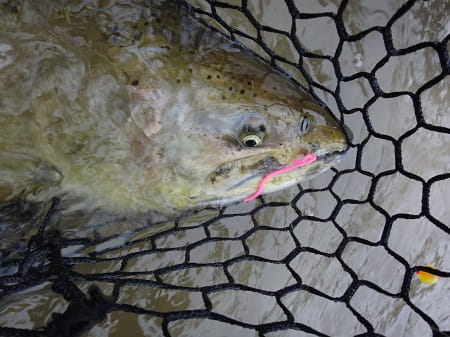
There are a number of good baits, but there are only a few that consistently catch fish.
There are days when one bait will produce more salmon for my clients than others, so I usually have six or more options with me on salmon fishing trips.
Somedays, the salmon will be all over one bait for some reason, and other days, they might want a different bait, a different color, or a different size.
Many anglers will stick with what worked yesterday, last week, or even last year, and they will use nothing but that bait, which can be a big mistake.
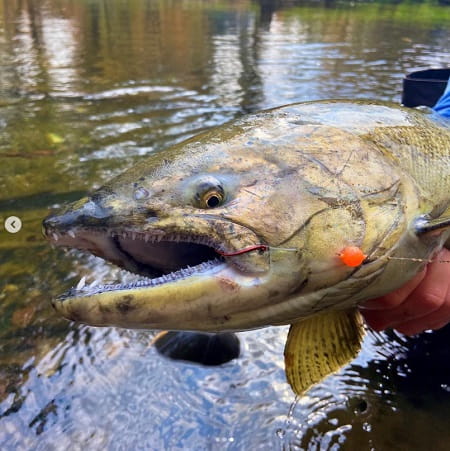
As a top river guide, it’s my job to get my clients onto as many fish as possible, so I need to be sure each and every day that I’m using the right bait for that day.
I discuss my secrets to determining which bait is the best for any given day or under different conditions on my page Best Salmon Baits For River Fishing.
The number one bait for salmon fishing is spawn bags and many anglers will use nothing more. I discuss that on my page about tips and tactics for using spawn when float fishing.
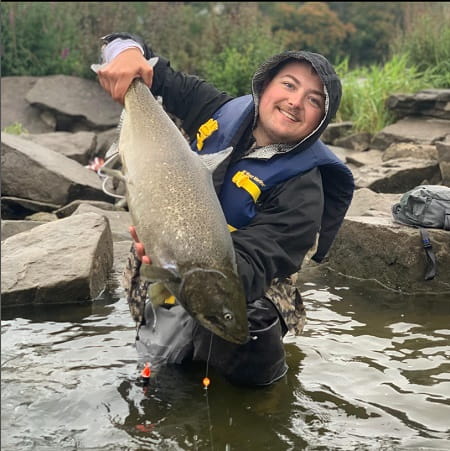
Another bait that has been of fire for many salmon anglers over the last few seasons has been trout beads.
In recent studies, salmon have been proven to eat loose salmon eggs once they enter the river.
Using 8mm and 10mm beads is a great way to imitate these eggs.
Check out my other page for all my tips and advice on salmon fishing with beads, which includes the best colors, best sizes, how to rig them, and even the best hooks for beads.
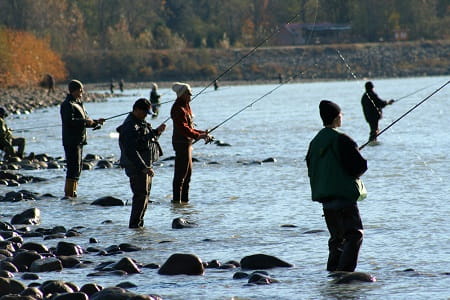
Flies like woolly buggers, prince nymphs, Zug bugs, pheasant tail nymphs, and stoneflies can often catch more fish than eggs, and I have proven that over and over again.
You can drift these flies under a float the same way you would with any other bait. I discuss this on my page Float Fishing With Flies.
See more great flies on my page 19 Best Flies For Salmon.
Another bait that has been very good when fishing for salmon is the plastic worm. I have done very well on the pink, red, and white 3 to 4-inch worms. My Favorite is the Berkley PowerBait Floating Steelhead Worm or the 4-inch Mad River Steelhead Worms, and although I favor the bubblegum pink color most of the time, the red worm is better some days.
Other baits that work for some anglers under the right conditions are:
- Minnows – Live and dead or salted minnows – See Fishing Salmon With Minnows.
- Minnow imitations like the Berkley Gulp! Alive Minnow – 4′‘
- Plastic grubs and flies like the Mad River Steelhead Grubs and the Berkley Gulp! Crickets and the Berkley Gulp! Pinched Crawlers
- Plastic single eggs and egg clusters like the Sac Attack Imitation Cluster Eggs or the Mad River Single Eggs, and the Berkley Gulp! Floating Salmon Eggs.
- Plastic leaches are worth a try. Berkley Gulp! 3” Leech or the Gulp Alive Leech.
- Jigs like the Hawken Marabou Steelhead Jig and the Jiggy Bugger Steelhead Jigs which are my favorites, or the Steelhead Worm Jigs, Kalin’s Marabou Jigs, Mimic Fry Jig, and the Fly Jig are all good options when salmon fishing with jigs under a float.
For more on all the baits for salmon fishing in rivers, check out Best Baits For Salmon Fishing.
Other Important Salmon Fishing Gear To Consider
- Net
- Waders and Boots
- Vests and Packs
- Glasses
- Release Tools
I cover all the best river fishing gear for all budgets on my page, River Fishing Gear: Everything You Need.
Presentation Is The Key To Salmon Fishing
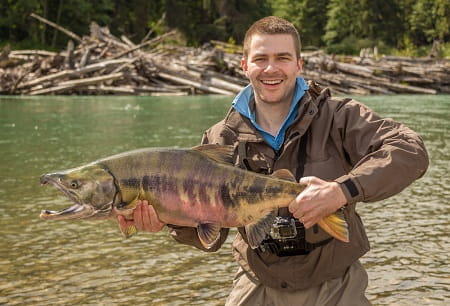
Presentation is the key to catching more salmon when float fishing.
There are four key things to a good presentation: speed control, depth, finding the strike zone, and effectively covering the water.
Better Speed Control: Trotting Your Float
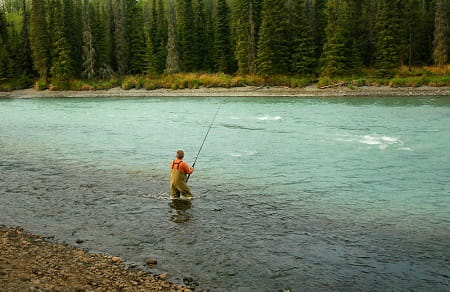
I didn’t realize how important speed was until I watched two clients fish with the same gear, the same setup, and the same bait and saw one guy catch ten fish while the other guy catches none.
I have actually seen this happen hundreds of times during my guiding career, but when I was a new river guide, I thought that if everything was the same, that the one guy catching all the fish was just lucky.
After seeing this multiple times, I finally realized that one angler’s float was moving slightly slower than the other angler’s float, which is why he caught more fish. This was an ah-ha lesson for me and one that changed everything.
I now tell my clients that the most important thing they can do when float fishing and with all methods used to free drift baits is to control the speed of their bait. In fact, if you learn nothing else from me, just mastering this skill will make you a far better angler.
To control their speed, anglers do this by slightly tilting the tip of the float upriver and allowing the surface current and the bubbles to go faster than the float. This is called “trotting” or some might call it “checking the float”. Doing this throughout the entire drift is the difference between catching ten or catching none. I have an entire page on how to control your speed when float fishing for more fish.
Finding The Bottom – Depth Control
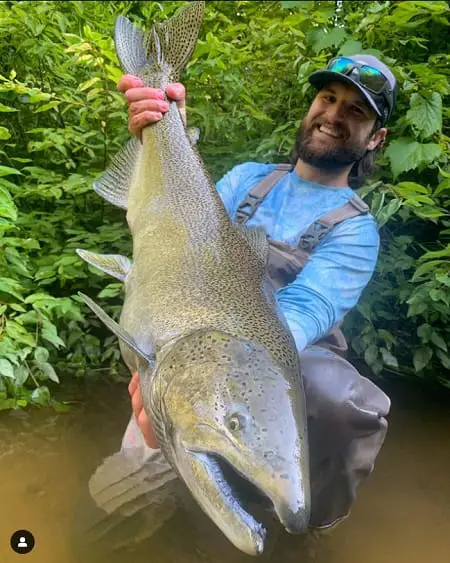
Salmon often hold close to the bottom, which means you need to get your bait down close enough to them that it’s in their strike zone.
To effectively get your bait to the bottom and in the strike zone, you need to keep sliding your float up the line, making the leader longer until you start dragging the bottom. Once you determine that you are on the bottom, you simply make it 1 foot shallower.
Finding the bottom can be done more effectively using the right floats, the right baits, and my specialized custom leader setup, which I discuss in more detail on my page How To Know How Deep To Set Your Float – 2 Easy Ways.
Covering The Water For More Salmon

Covering the water well is one of the key fundamentals of good float fishing and one that many new anglers do not do well.
This includes where you position yourself for the best presentation, and where you drift the bait.
Salmon don’t always sit where you think they should be, so I have a systematic approach to covering the water so that I don’t miss any fish. This systematic approach has helped me find hot spots that concentrate fish that other anglers miss.
One of the first things I do is try to be at the top of the spot and only fish down towards the fish. This allows me to get a better line, float, and speed control, all of which are important if you want to catch more salmon.
I discuss all my tactics on how to cover the water better on my page, Effectively Covering The Water When Float Fishing.
Tight Lines
Graham

Great article Graham,
Could you please elaborate a bit on when would the Salmon prefer a minnow style bait over eggs or rubber worms.
And targeting them on the fly like the wolly bugger and gulp minnows is a complete dead drift better than say a retrieve where you trot the float in minuet steps of slow and fast speeds thus causing small up and gown jigging motion on the buggers and other streamers to get a reaction bite?
I came across a pod of 3-4 salmon tried dead drifting , worms/woollybuggers/ egg sucking leeches couldn’t get them to bite at all except for one swipe at the egg sucking leech .
Hi Durvesh,
I dead drift baits that don’t normally have movement in the river and on occasion I might bounce or jig a bait like a minnow, a fly, or a jig. However, it will depend on the spot. 3 or 4 salmon holding in a smaller clear pool are likely to be nervous fish, therefore jigging or causing any type of commotion on the surface can spook them even more.
In larger faster flowing spots jigging or holding back and releasing your float might work but 90% of the time I will dead drift a jig and it seems to work well. check out my page on using steelhead jigs.
Make sure you use the right type of float for the type of water you are fishing, make sure you have the right leader set up and the right size leader for the spot, and make sure you fish well and don’t spook the fish.
Honestly, some salmon just won’t eat once they enter the river no matter what you do or try.
Check out my best baits for salmon for more info that might help.
Hope that helps.
Thanks a lot Graham,
I will definitely pay a second visit to your article on fishing steelhead jigs.
I was using 8lb seagaur as tippet and 10lb as shotline, just like your suggestions along with a drennan loafer float(I follow all your recommendations they seem to work great!).
As per your reply it seems that these fish behave like finicky /spooked fish .
I was wondering if you could elaborate a bit more about bait selection for the conditions, eg when would you use a leech pattern over a stonefly or a worm? etc.and their size, I am generally dead drifting size 8 flys in the above pattern.
I wanted to start with the right fly choice as I dont wish to drift the wrong bait for the condition and lose my changes of getting a bite when I eventually rotate to the right one.
I did target the deep pools(6-8 ft) the next day as per your recommendation and did manage a bite on an egg fly on dusk.Later my friend came over to the spot and gave me some skien, I hooked 4 Salmon in 30 mins.
It is so ironic that fishing for salmon is considered unskillful in comparison to steelheads. I on the other hand, am not having any problem catching steelheads in the rivers but I am finding Salmon a tough cookie to crack!
Hi Durvesh,
I will often use smaller less intrusive baits like flies in low clear waters and bigger brighter baits in bigger pools or faster water. start small and work your way up.
Trying to determine if the fish want a worm or an egg or a minnow is trial and error and I will often rotate baits in each spot until I find something that works.
Make sure you use the right type of float for the type of water you are fishing, make sure you have the right leader set up and the right size leader for the spot, and make sure you fish well and don’t spook the fish.
Sometimes salmon can be very aggressive when something enters their space so they may hit an aggressively retrieved fly, jig, or lure out of anger or a territorial thing, so sometimes a switch to a lure will do the trick. However, that is always my last resort since that can also spook the fish.
Honestly, some salmon just won’t eat once they enter the river no matter what you do or try.
My guides all use skein when fishing for steelhead and at times it can be excellent and the most effective bait you can use. You can see more about using skein on my page about the best salmon baits.
Good luck.
Hi, Graham,
I want to get a an all purpose float fishing combo(salmon and steelhead), and found this
https://www.fishusa.com/Shimano-Symetre-Salmon-Steelhead-Spinning-Rod-Reel-Combo?quantity=1&IO-Rod-Model-Shimano=87
what are your thoughts on it?
And to go with it the addicted fishing winter chrome kit ll
do you think it would work for salmon to?
(working on tight budget $170 us)
Hi Jonathan,
A lot depends on where you are fishing, the type of water you fish, the type of fish you are targeting, and what methods you want to fish.
I think the rod is Ok for the price but I don’t have extensive knowledge of using it and testing it for salmon so I can not say for sure if it’s good or not. For great lakes area, I think it is too heavy and too short if you are primarily targeting steelhead with floats. However, it will do if your budget will not allow for anything more suitable and if you are primarily using it for salmon and if you plan to both float fish and cast lures with it.
As far as the addicted fishing Chrome Kit goes, the jigs look good and the floats are Ok, but I have no idea of the quality of the line and leader and I’m generally pretty picky when it comes to lines and leaders. I’ve seen lots of cheap crappy lines on the market that cause lots of problems.
I’m also not sure why the guys that make that product would use 40lb braid when the leaders used for salmon are usually 12 to 20 pounds, their kit even comes with a 15 pound leader so why go with a high as a 40 pound braid. The leader is always the weakest link so a 40-pound braid is not necessary especially since I find thick mainlines are problematic when float fishing and sometimes when casting. Generally, thinner lines cast better and are best when float fishing, so I always recommend going as light as possible on all your lines.
For a 15 pound leader, I would pair it with an 18 to 20-pound braid or mono instead. 40 pounds is overkill in my opinion.
I also think the worms in the kit are too big for Great Lakes steelhead. Absolutely they will catch steelhead and salmon, but I have found jumbo worms don’t always work on low clear waters of the great lakes, and they are better only in high water or on very aggressive fish. I would go with a 3 and 4-inch worm for lower clear water and 5 inch worms for bigger, faster, or dirtier water. It makes sense to have multiple sizes and colors.
That kit, like most kits, is for absolute beginners that just want a kit to get them going, and it will do just that. It is a general-purpose kit that will work for that purpose. However, if it was a close freind or family member asking for great advice, I would recommend buying the line, the leader and the baits all separate and getting exactly what will work best in your area.
Good Luck,
Graham
Hi Graham,
Do you have any experience using the Luhr-Jensen Legacy sst spinning rod?
Hi Jonny Boy, If you mean the Luhr-Jensen Legacy Series 2 Piece Salmon/Steelhead Spinning Rod, (not the SST) I hear the 2022 version of this rod is a decent rod for the price but I don’t know enough about it to recommend it. Some of the rods that I use and recommend that might be better are found on my page Best Salmon Rods For Rivers.
If you get one of the L-J rods, let me know how it is. Thanks
Graham
Thank you so much!
I think I will go with the 10’6 medium.
Hi Graham,
Hope you are doing well. I’m getting ready to go fishing to Port Alberni for Sockeyes with my centerpin set up for the first time. Beyond excited! I’ve practiced the BC swing and I the Wallis cast …maaaan I m ready to roll :))
However, my concern is this….I have no idea how deep I will have to fish.
FYI, I have an adjustable fixed float. High vis 15lbs floating mono blood run (0.37mm) + Fluo Pline (0.31mm) for the shot line and Seagar Red label 10 lbs (0.26).
How do I determine the total length of my leader? Is it ok to have a little bit of high vis under water or the leader (fluorocarbon) should be the only part under water.
For now, I connected using a surgeon knot 6 feet of fluorocarbon to my main line with my float and bulked some shots above a micro swivel followed by 22 inches leader (and a hook of course lol).
Are you shaking your head like what the…is he doing? Or am I doing ok?
Thanks in advance for your input!
Olivier
Hey Oliver,
All good questions buddy, I hope you are successful and my answers help.
First, check out my article How To Know How Deep To Set Your Float – 2 Easy Ways
Second, I would recommend attaching the mainline and fluor leader with a swivel. I have found that fluoro to mono knots are not very strong, I thinkthe flouro bites into the mono and break it easier. Better to use a swivel.
As far as how long your leader should be, if you are bult shotting, or even spreading them out like I do, 5 to 7 feet from the hook to the top of the flouro should be plenty. Keep in mind when your bait comes drifting down the river, the salmon won’t be looking up and looking for your mainline. Therefore, a 5 to 7 foot fluorocarbon buffer between your mainline and bait is usually plenty. And, I hope that answers you question about having mainline below the surface, you can have 10 feet of high viz mainline below the surface if you wanted, as long as there is that 5 to 7 foot of flouro keeping your bait apart from the mainline.
You can go with a longer leader if you want.
Good Luck,
Graham
THANK YOU! Truly appreciate your help! So awesome to have a professional like you taking the time to answer any questions! I’m in BC you’re in ON man how crazy is that!!! Wish you all the best Graham!
Olivier